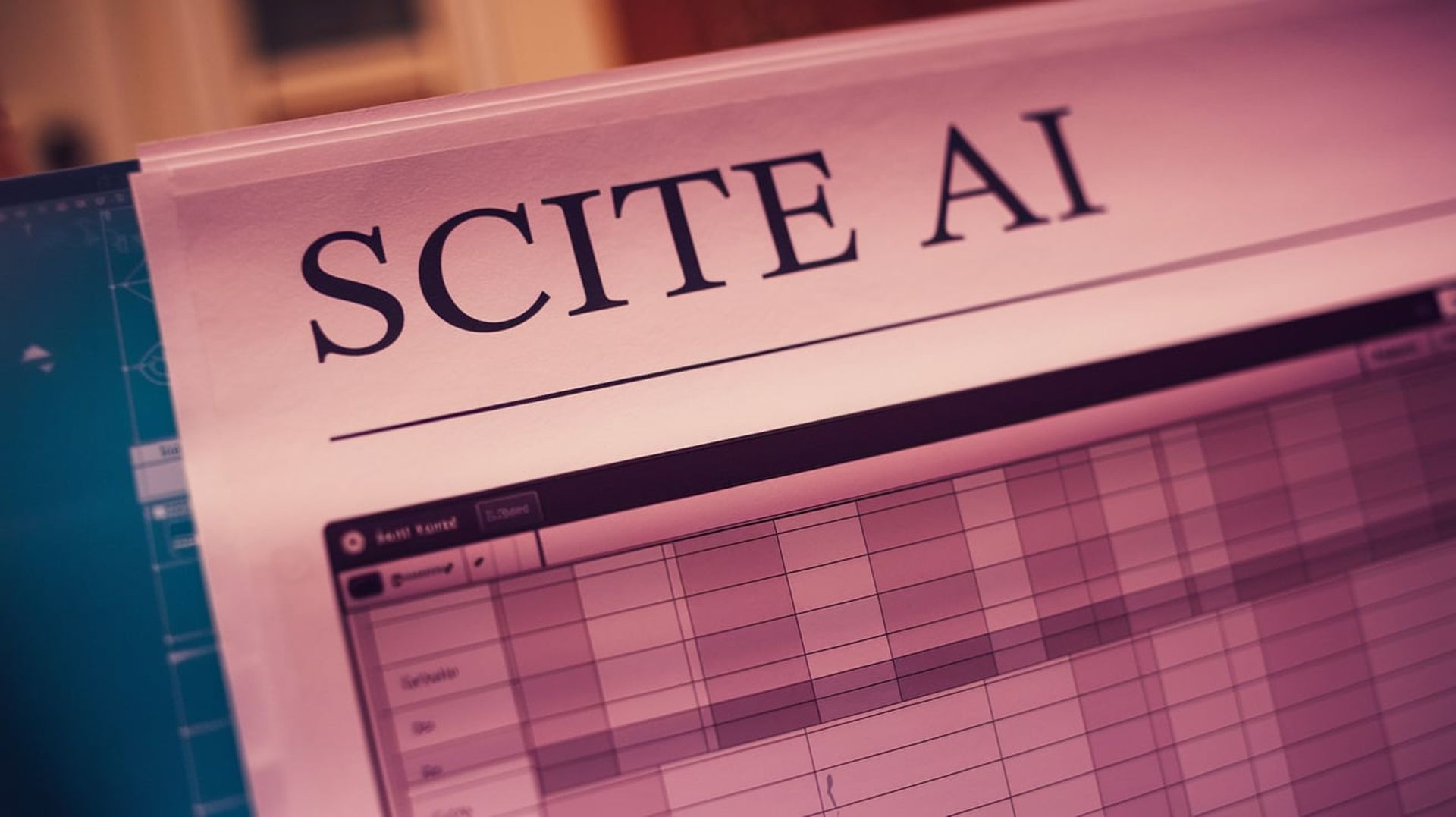Hey academics, our Scite AI review went pretty well

Recently, we saw one of our colleagues struggling to write his thesis, caught in the maze of endless research papers and references. Tools like Scite AI offer a good opportunity to cut through the noise. They act as a gateway to quicker discovery, helping users find relevant papers and understand how those works have been cited in the academic community.
What is Scite AI?Scite AI is an academic tool that helps researchers, students, and academics make sense of vast amounts of scientific literature. At its core, it’s designed to give users not just access to research papers but a deeper understanding of them by using AI to analyze how those papers have been cited. Instead of just showing a simple citation count, it looks at whether a study has been supported, disputed, or merely mentioned by others, giving a clearer picture of its impact.
This makes the process of literature review or research much faster and more focused. Instead of spending hours combing through references to see how credible a study is or how much it’s influenced a field, Scite gives that insight upfront. The tool also offers an AI-powered assistant that can answer detailed questions based on the literature, providing citations and related research for a more comprehensive answer. It helps simplify the process of diving into new topics or fields where understanding the context is crucial.
 Scite AI is an academic tool that helps researchers, students, and academics make sense of vast amounts of scientific literature (Image credit)
Features of Scite AI
Scite AI is an academic tool that helps researchers, students, and academics make sense of vast amounts of scientific literature (Image credit)
Features of Scite AI
Scite AI comes packed with several features that are designed to streamline the research process and help users get the most relevant, credible information efficiently.
One of the standout features is Smart Citations, which provide a more nuanced view of how research papers are cited. Instead of just giving a raw number of citations, it shows whether those citations support, dispute, or simply mention the original paper. This allows users to quickly gauge the credibility and influence of a study without having to dig through countless references themselves.
Another useful tool is the AI-Powered Assistant, which can answer complex academic questions. Whether you’re looking for a summary of a concept or trying to find key research on a topic, the assistant not only provides answers but backs them up with cited references, giving you the confidence that the information is grounded in real research.
The platform also has a Search and Literature Discovery feature that uses AI to help users find relevant papers based on specific terms or questions. The results come with citation context, so you get a fuller picture of how each piece of research fits into the broader academic conversation.
For those managing large numbers of references, Scite AI offers Citation and Reference Management tools. You can organize, track, and stay updated on the latest research, all from custom dashboards, which makes it easier to keep tabs on everything in one place.
 Scite AI comes packed with several features that are designed to streamline the research process (Image credit)
How to use Scite AI?
Scite AI comes packed with several features that are designed to streamline the research process (Image credit)
How to use Scite AI?
Here’s a straightforward guide to help you get started and make the most out of Scite AI!
Step 1: Visit the websiteHead over to Scite’s homepage. You don’t even need to sign up right away—you can try the tool instantly. On the first page, you’ll see a search bar where you can input your research questions. In our case, we entered “How to conduct a sentiment analysis using generative AI tools?” and received a detailed, technical answer with citations attached, all without signing up.
Step 2: Ask a research questionAfter typing your question, Scite AI immediately provides a well-structured response. For instance, when we searched the protein structure question, it broke down the concept clearly, explaining protein folding, and referenced scientific papers to back up each point. This saves time compared to manually searching through individual papers.
Step 3: Analyze citation contextThe answer doesn’t stop at just providing information. Scite goes further by showing you how various studies cite the paper. In our example, we could see whether other research supports, disputes, or simply mentions the study on protein structure, making it easier to assess the credibility of the source.
Step 4: Use the AI search toolOn another page, we tested Scite’s AI search by entering “sentiment analysis.” This pulled up relevant academic papers, showing the context of each citation. This feature makes exploring a broad topic more manageable, as the AI helps focus on the most cited or influential papers, providing a well-rounded view of the research field.
Step 5: Review the referencesScite doesn’t just stop at showing a few sources. It provides a complete breakdown of the publications it used to generate your answer. As we saw in the sentiment analysis search, it listed multiple scientific articles, with DOI links, making it easy to verify the information or dig deeper into the subject.
Step 6: Manage your citationsOnce you find the research you need, Scite AI allows you to save and organize papers into custom dashboards. In our experience, after searching for different terms, we could easily add relevant studies to a dashboard, helping us keep track of references for future use.
 Scite AI offers two main pricing tiers designed to cater to both individual users and institutions (Image credit)
Is Scite AI trustworthy?
Scite AI offers two main pricing tiers designed to cater to both individual users and institutions (Image credit)
Is Scite AI trustworthy?
Whether Scite AI is trustworthy is something only you can decide. While it offers valuable tools for research, like any AI, it’s not immune to mistakes.
It’s important to review the results carefully and ensure the sources align with your own research standards.
Best plagiarism checkers for ChatGPT and other AI tools
Scite AI pricing plansScite AI offers two main pricing tiers designed to cater to both individual users and institutions.
Personal Plan: $20.00 per monthThis plan is ideal for students, independent researchers, and professionals who want to enhance their research experience with AI tools. Key features include:
- Unlimited assistant chats: You can ask the AI assistant an unlimited number of questions, allowing you to continuously explore new research topics and get detailed, cited responses.
- Unlimited search usage: Perform as many searches as you need without worrying about hitting any limits. This is crucial for in-depth research or when working on multiple projects at once.
- Reference check: The platform offers a detailed reference check for papers, ensuring that you can easily verify the credibility and context of the sources you’re using.
- Custom dashboards: Keep your research organized by creating custom dashboards to track and manage papers, making it easy to revisit key studies or share them with colleagues.
- Citation and retraction alerts: Stay updated on the papers you’ve tracked. If a paper you’ve referenced is cited, or even retracted, Scite will alert you, keeping your research up-to-date and accurate.
This plan is tailored for universities, research labs, and academic institutions. It comes with all the features available in the personal plan, but with additional benefits designed for larger teams and organizations:
- All features included: You get full access to all of Scite AI’s tools, including unlimited assistant chats, searches, and citation tracking, just like the personal plan.
- Discounted rates for more users: Institutions can benefit from volume-based discounts, allowing teams of researchers or students to access Scite at a reduced per-user cost.
- Centralized billing and admin: Scite offers centralized billing and administrative controls, which is essential for managing large groups or departments. This helps institutions streamline their payment process and manage user accounts efficiently.
- Dedicated support & training: Institutions get access to a dedicated support team that offers personalized training and guidance on how to best use the platform. This can help teams onboard quickly and maximize Scite’s benefits for their research goals.
These tools make the research process smoother, there’s no denying. Yet, it’s important to stay ethical and vigilant when it comes to plagiarism. Scite AI, for example, did a good job of showing resources clearly on the right side of the screen, making it easy to track citations. This level of transparency is useful for maintaining academic integrity and avoiding any accidental missteps in sourcing.
Scite AI worked out fine during our experience. If you’re deep into research, it might be worth a try to see how it fits into your workflow.
Featured image credit: Kerem Gülen/Ideogram
